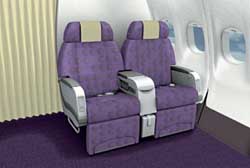2006-05-19
Resin for high-performance textiles and nonwovens targets key trends in aircraft interior applications

GE Plastics have announced a major breakthrough in fiber technologies made from the company¿s high-performance Ultem* polyetherimide (PEI) resin with inherent flame retardance to help address a number of challenges facing the aircraft interiors industry. When converted into fibers for textiles and non-wovens, GE¿s Ultem resin offers suppliers and OEMs new solutions for critical issues such as compliance with stricter flame, smoke, and toxicity regulations, system cost reduction, and greater design flexibility.
¿The aircraft industry today faces tremendous pressure to improve the customer¿s experience while reducing costs and complying with increasingly stringent regulations,¿ said John Kaminsky, market director, New Markets at GE Plastics. ¿GE Plastics is expanding its offerings for aircraft interiors with new materials that can be converted for use in high-performance textile and non-woven fibers to provide design, safety, and performance benefits in a wide range of applications, including ¿smart¿ fabrics, carpeting, filters, and insulation systems.¿
GE has invested several years in researching and developing resins and compounds that are excellent candidates for conversion into high-performance fibers. For aircraft interiors, these GE materials offer new approaches to compliance with regulations on flame, smoke, and toxicity, including environmental mandates for flame retardants that eliminate the use of brominated additives. These regulations have become increasingly strict following the 1998 crash of Swissair Flight 111, which was attributed to a cabin fire caused by faulty wiring.
GE¿s Ultem Resin Offers Inherent Flame Retardance
GE¿s Ultem resin supports regulatory compliance by providing inherent flame retardance without the need for additives. The intrinsic flame retardance of Ultem resin can also protect aircraft cabin fabrics and carpet better than traditional textiles and nonwovens that are surface-treated with flame retardants; these treatments can wash off over time.
Another innovative application for fibers made with Ultem resin is in composite panels used to attach seating to the cabin floor. These panels can be created by mixing fibers made from Ultem resin with glass fibers into hybrid yarn. The yarn is woven into fabric - by Carr Reinforcements, a leading U.K.-based weaver of high performance fabrics - that is then heated and molded to offer such benefits as greater design flexibility, reduced system costs through reduction of the number of system components, ease of assembly, and the inherent flame retardance that Ultem resin provides.
Eric Taylor, director at Carr Reinforcements, said, "We believe GE's thermoplastic composites have great potential for growth in industries like aviation interiors where high performance and safety are critical. Fibers made from Ultem resin are easy to weave and produce a superior fabric. The use of hybrid yarns that closely blend the thermoplastic material and the reinforcement fiber delivers excellent mechanical properties and allows the manufacture of complex parts. This innovative technology offers our company the opportunity to move into new markets."
Information about the company: Saudi Innovative Plastics Sweden AB